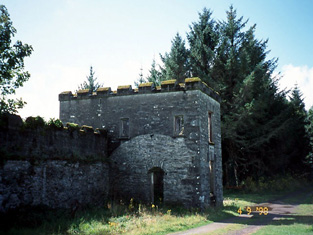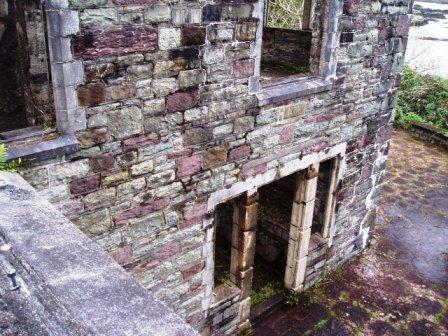Coomlumminy Court
Houses within 15km of this house
Displaying 14 houses.
Houses within 15km of Coomlumminy Court
Displaying 14 houses.
| House name | Description | |
|---|---|---|
| Looscaunagh | Henry Herbert was leasing a property valued at almost £4, along with over 400 acres, to Daniel McCarthy at the time of Griffith’s Valuation. It is no longer extant. | |
| Derryquin Castle | At the time of Griffith’s Valuation James F. Bland was leasing a property valued at £29 at Derryquin, from the Guinness estate. Lewis, in 1837, and Leet, in 1814, record the house as the seat of Francis C. Bland . The property was eventually sold by the Blands to the Warden family. In 1906 it was owned by Col. Charles W. Warden and valued at £70. The Wardens resided there until it was burnt in 1922. It was located in the grounds of what is now the Parknasilla Hotel but the ruins were demolished in 1969. See www.parknasillahotel.ie for e-book on the history of this property. |

|
| Hollywood | Frederick Hyde was leasing a house valued at almost £10 from the Bland estate at the time of Griffith’s Valuation. Lewis records Hollywood as the seat of the Hyde family in 1837. Frederick Hyde was married to Elizabeth Bland. Bary states that the house was built in the 1830s, possibly on the site of an older house. It was occupied by the Bland family after they sold Derryquin but later fell into disrepair and is now a ruin. | |
| Parknasilla | James F. Bland was leasing a house valued at £10 to Christopher Bland at the time of Griffith’s Valuation. Bary states that some historians believe this to be the original Bland house in the area. In the mid 19th century it became known as the Bishop’s House as it was leased by the Bland estate to Bishop Graves of Limerick. Later still it became the forerunner of the Parknasilla hotel, in which grounds it is still located. A second house in the townland is labelled Clashnacree House [V721649] on the 25-inch Ordnance Survey map of the 1890s. In 1894 Slater records this latter house as the seat of J.F. Fuller. It is still extant. | |
| Gortmaloon | James Breen was leasing a house valued at £8 15s along with 500 acres from the Landsdowne estate at the time of Griffith’s Valuation. The building is no longer extant. | |
| Glencar Hotel | John Breen was leasing a house valued at £7 5s along with almost 200 acres from the Landsdowne estate at the time of Griffith’s Valuation. On the 25-inch Ordnance Survey map of the 1890s, the building in this townland is labelled Glencar Hotel, which is still the name it is known by today. The hotel history indicates the property may initially been used as a hunting lodge for the Landsdowne estate. See www.glencarhouse.com. |

|
| Drimna House | James F. Bland was leasing a house valued at £7 to Rev. Arthur Watson at the time of Griffith’s Valuation. In 1906 Col. Charles W. Warden owned a property at Drimnamore, valued at £3 10s. It is still extant. | |
| Dromore Castle | The reps of Rev. D. Mahony were occupying a property valued at £66, at the time of Griffith’s Valuation. Lewis mentions " a noble edifice in the Gothic castellated style" as the seat of Rev. Denis Mahony in 1837. In 1814, Leet noted Dromore as the seat of John Mahony. In 1906 it was owned by H.S. Mahony and valued at £66 15s. Bary states that it was built by Sir Thomas Deane for Rev. Denis Mahony in the 1830s. It remained in the Mahony family until the early years of the twentieth century. It then passed by marriage to the Hood family. The Irish Tourist Association survey in 1943 indicates it was the property of Colonel E. Hood whose wife was "the last of the O'Mahonys, a family associated with the area for over 300 years". It later pass from them to the Wallers, cousins of the Hoods. Dromore Castle is still extant and the National Inventory of Architectural Heritage states that it was renovated in 1998. |

|
| Old Dromore House | The representatives of Rev. D. Mahony were leasing a house valued at £25 to James McClure at the time of Griffith’s Valuation. The McClures were the agents for the Mahony estate for many years. It is labelled "Dromore Old" on the 1st edition Ordnance Survey map and as "Old Dromore House" on the later 25-inch edition of the 1890s. Bary states that it was the original Mahony house before the building of Dromore Castle. It is not extant now. | |
| Lickeen | James O'Connell was leasing Lickeen House, valued at £11 15s, to Francis Newton at the time of Griffith's Valuation. Bary states that the second of two houses at this site was built by Francis Newton in the mid-nineteenth century but that the original Lickeen House is much older. Later the Eager family lived here. Lickeen House is still extant and occupied. | |
| Gearha | In 1906 Mary Mahony owned this property valued at £4 5s. At the time of Griffith's Valuation, Frederick Hyde was leasing it from the Mahony estate when it was valued at £2 5s. Buildings are still extant at the site. | |
| Marino Lodge | In 1906 John Columb owned this property, then valued at £6 10s. There are two bathing lodges in this area at the time of Griffith's Valuation, Marino Lodge and Clashganniv. These properties seem to have been part of the Langford estate. | |
| Rossdohan | In 1906, Samuel T. Heard, MD, owned this property at Rossdohan, barony of Dunkerron South, when it was valued at £27. Bary states that this house was built in 1875 by Thomas Heard, a surgeon who had retired from India. He died in the early 1920s and the house was burned around that time. There are remains of a later house still visible on the island. |

|
| Clodragh or Derriana Lodge | Part of the Mahony estate at the time of Griffith's Valuation when it was held in fee by Daniel Mahony and valued at almost £2. Bought by the Williams family in the late 1850s following the sale of the Mahony estate, the lodge seems to have become known as Derriana Lodge by the end of the nineteenth century. There are still buildings at this site. |

